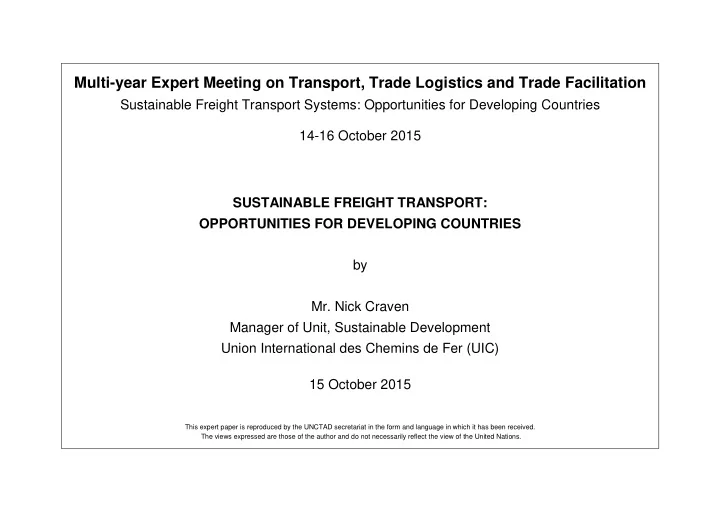

Multi-year Expert Meeting on Transport, Trade Logistics and Trade Facilitation Sustainable Freight Transport Systems: Opportunities for Developing Countries 14-16 October 2015 SUSTAINABLE FREIGHT TRANSPORT: OPPORTUNITIES FOR DEVELOPING COUNTRIES by Mr. Nick Craven Manager of Unit, Sustainable Development Union International des Chemins de Fer (UIC) 15 October 2015 This expert paper is reproduced by the UNCTAD secretariat in the form and language in which it has been received. The views expressed are those of the author and do not necessarily reflect the view of the United Nations.
S USTAINABLE FREIGHT TRANSPORT : OPPORTUNITIES FOR DEVELOPING COUNTRIES Nick Craven International Union of Railways (UIC) UNCTAD Geneva, 14 October 2015
UIC in 2015 2 2
UIC today 240 Members in 95 countries 3,000 billion passenger kilometres 10,000 billion tonnes kilometres 1 million kilometres of lines 7 million rail personnel Cooperation with over 100 institutions 700 UIC Leaflets (international railway standards) 85 congresses, conferences, workshops 3
Rail freight activity 4
Railway energy efficiency 5
2014 Voluntary UIC targets in line with the 2 degrees scenario 6
Freight traffic in China by transport carrier 1980-2012 (million metric tons) 35000 Freight traffic in million metric 30000 Air Rail Road Water 25000 20000 tons 15000 10000 5000 0 1980 1985 1990 1995 2000 2005 2010 2011 2012 Source: Ministry of Transport of China, China Statistical Yearbook 2013, page 571 7
Rail vs Road environmental impact 100 ton, 1, 390 km from the dry port in Kigoma to Dares Salaam, Tanzania Source: www.ecotransit.org 8
Rail freight offers competitive journey times 9
Policy requirements for dry ports Source : ESCAP Institutional and Regulatory Issues for the Development and Operation of Dry Ports (2010) 10
China case study Effective regulation of rail projects • 1979 Environmental protection law • 1986 State Environmental Protection Agency issues environmental projection measures for construction projects: - All projects have an Environmental Impact Assessment (EIA) with mitigation hierarchy (avoid, mitigate, offset) - Integration of pollution prevention in design, construction & operation • 1995 the Ministry of Railways develop a broader set of environmental projection, regulations, guidance & standards & improve enforcement • Capacity building through visits to Germany, USA and France 11
China case study Effective regulation of rail projects Guiyang-Guangzhou Railway Project: Realignment during the feasibility study to avoid forty environmentally sensitive sites Tunnel – bridge- tunnel schemes used for 81% of the route to minimize land take and ecological foot print Borrow pits retuned to local community for use a fish ponds Excavated material (spoils) used for embankments and converted to arable land 12
Case study Indian dedicated rail freight corridor Major contracts currently being tendered / awarded for the Western and Eastern corridors, total 3360 km of new freight route Specific fuel consumption for electric traction in DFC scenario would be 30% lower than No-DFC scenario Over the 30 year period, this will save 485 million ton CO2 75% reduction relative to the baseline 13
Africa case study Rail concessions in Africa Huge potential unlock development, particularly for landlocked countries and remote areas Private sector involvement (PPP): - increase in productivity and service - requires strong regulatory capacity - infra renewal required public financing - overall mixed results Fair competition with road fright is needed (regulation & pricing) Internalization of external costs Common standards (gauge, axle weights & line speed) to support future network development and internal trade 14
Conclusions Development of dry ports (Land locked developing countries, etc) & promotion of combined transport have huge potential Simplification of boarder crossings in needed (Eurasian Customs Union & European Union) Fair competition based with the road sector is essential Internalisation of external costs (road tolls, etc) Infrastructure development & renewal requires public support Private sector involvement can improve productivity & service, but requires strong and informed regulation & terms 15
Please visit our new website: www.uic.org
Recommend
More recommend